The costs of obtaining food security in Vietnam
Global food crisis happened in 2008,
all countries in the world must pay attention
on food security. Although Vietnam is a food
export country, food security is targeted
as a priority in the process of economic
development. Obtaining food security will
gain political and social stabilities, but it
may create negative impacts on agricultural
development and economic development
as a whole. This paper overviews some
key policies on food security, analyses the
current food security, projects food security
in Vietnam until 2020, investigates the costs
of obtaining food security and draws policy
recommendations.
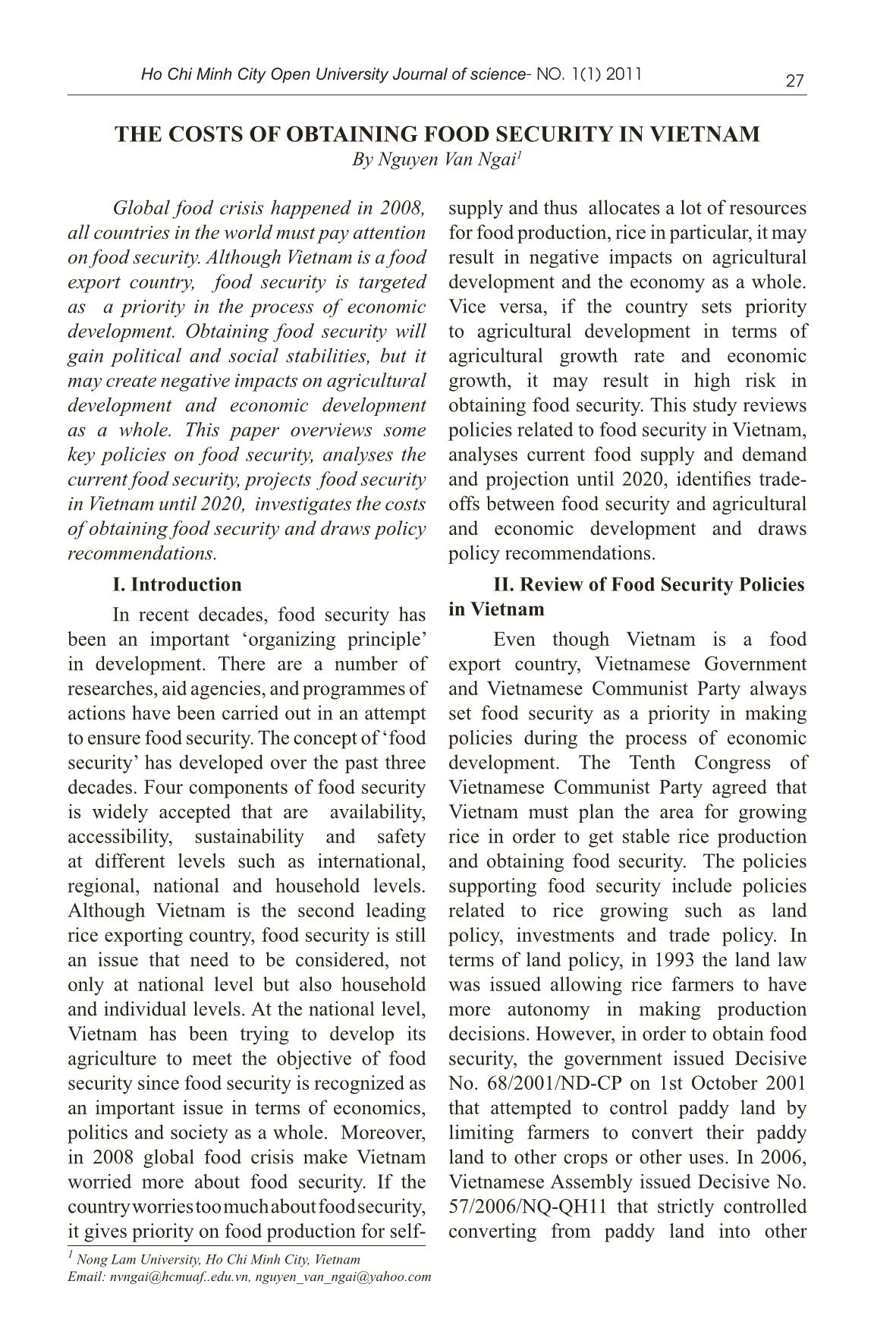
Trang 1
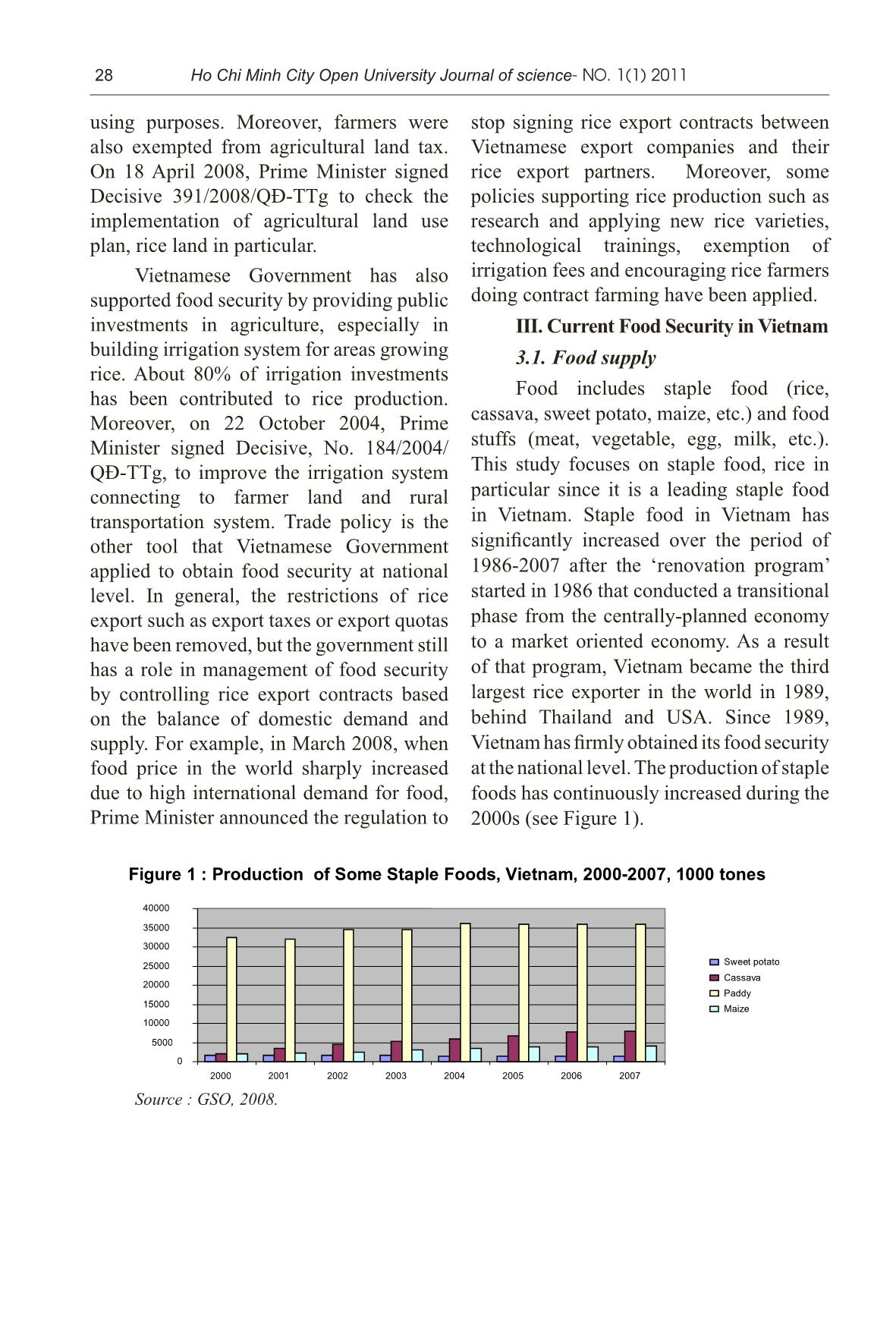
Trang 2
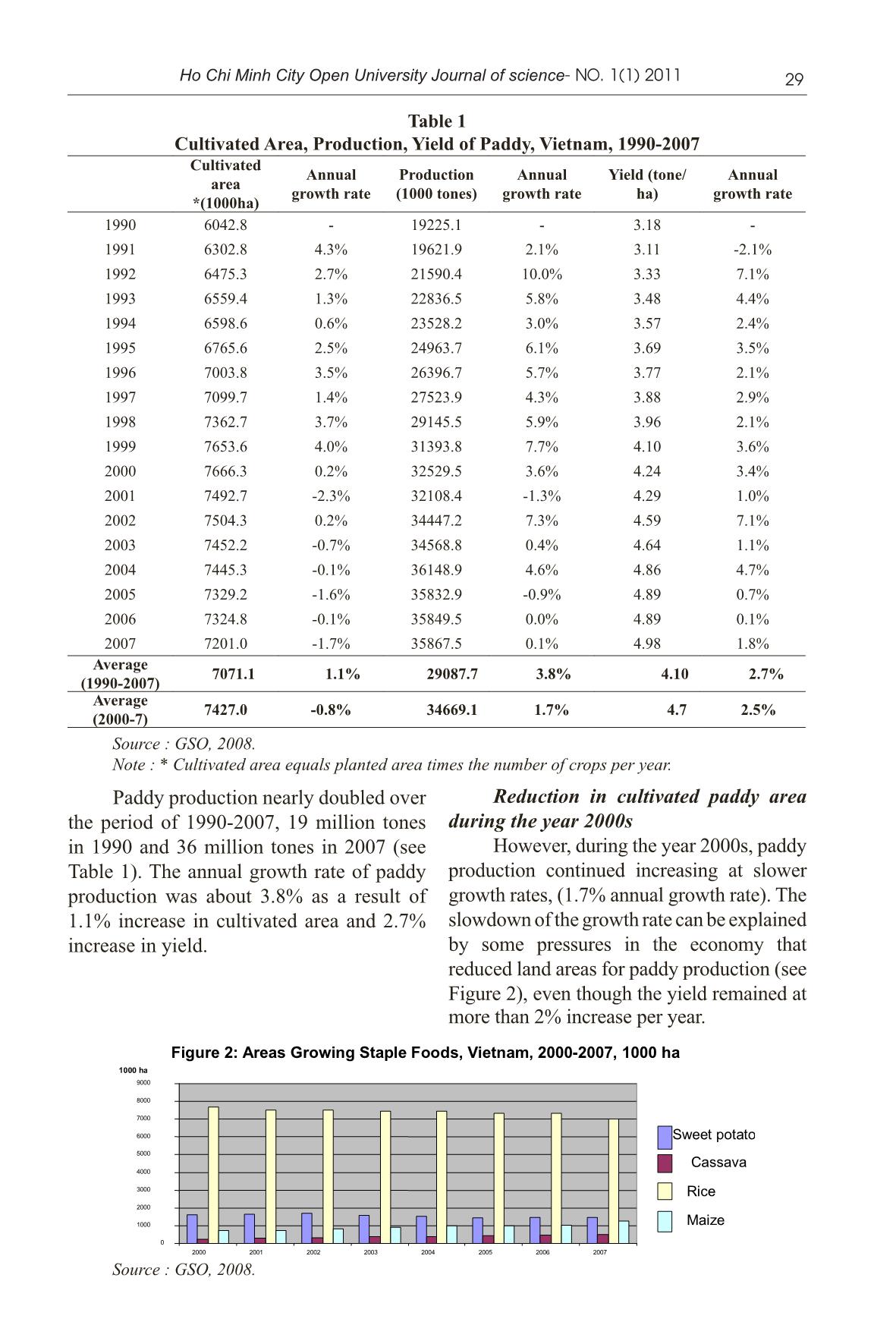
Trang 3
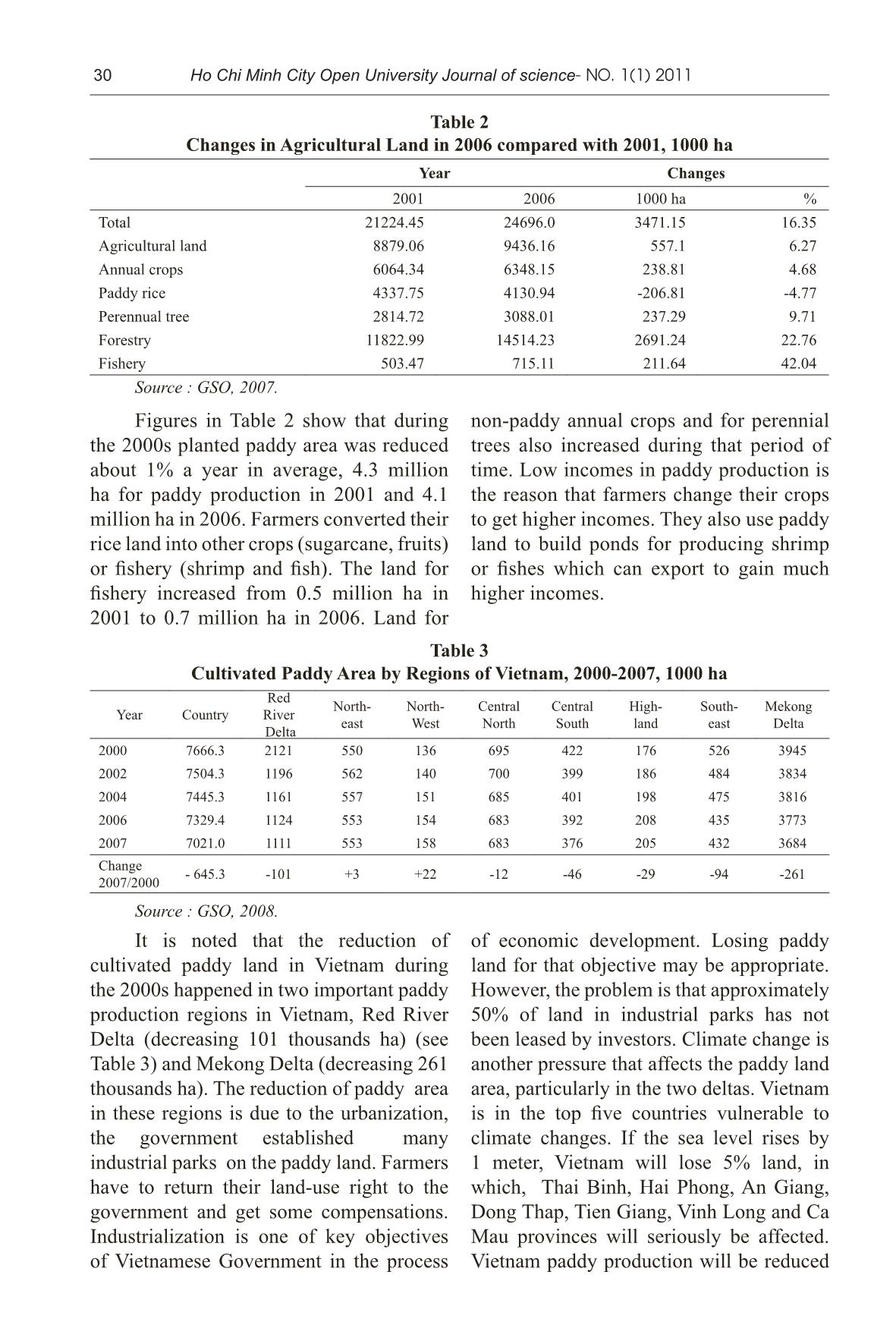
Trang 4
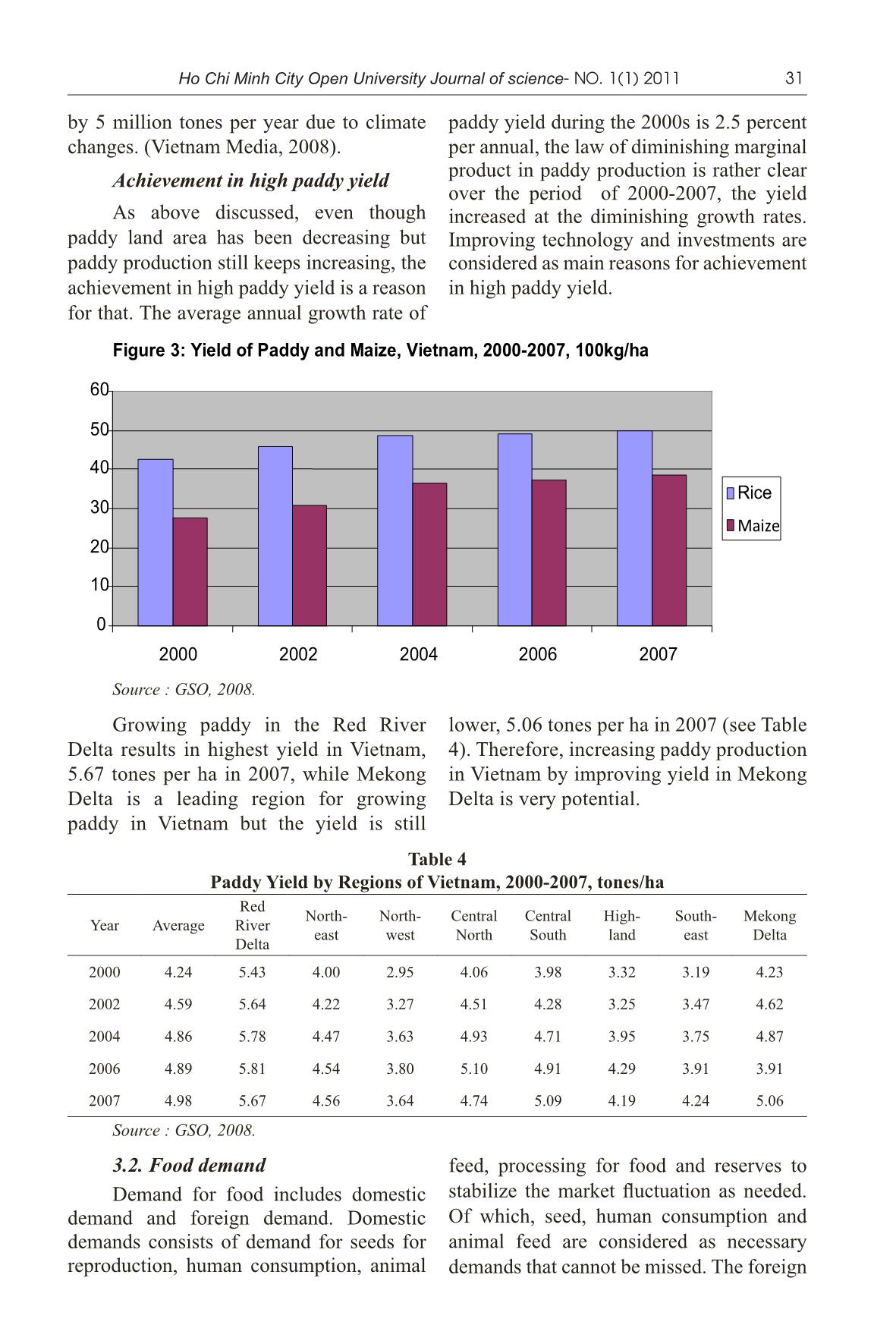
Trang 5
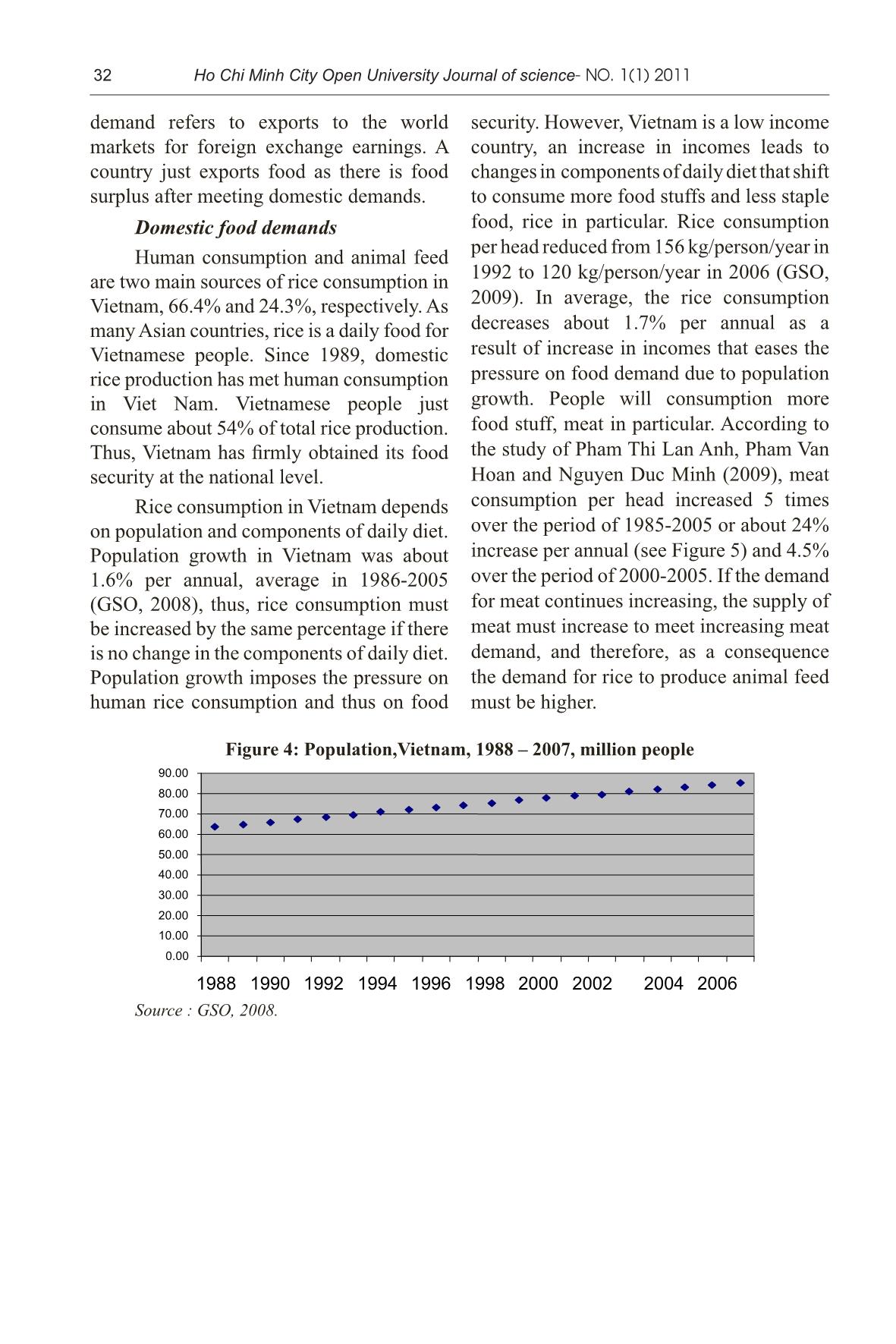
Trang 6
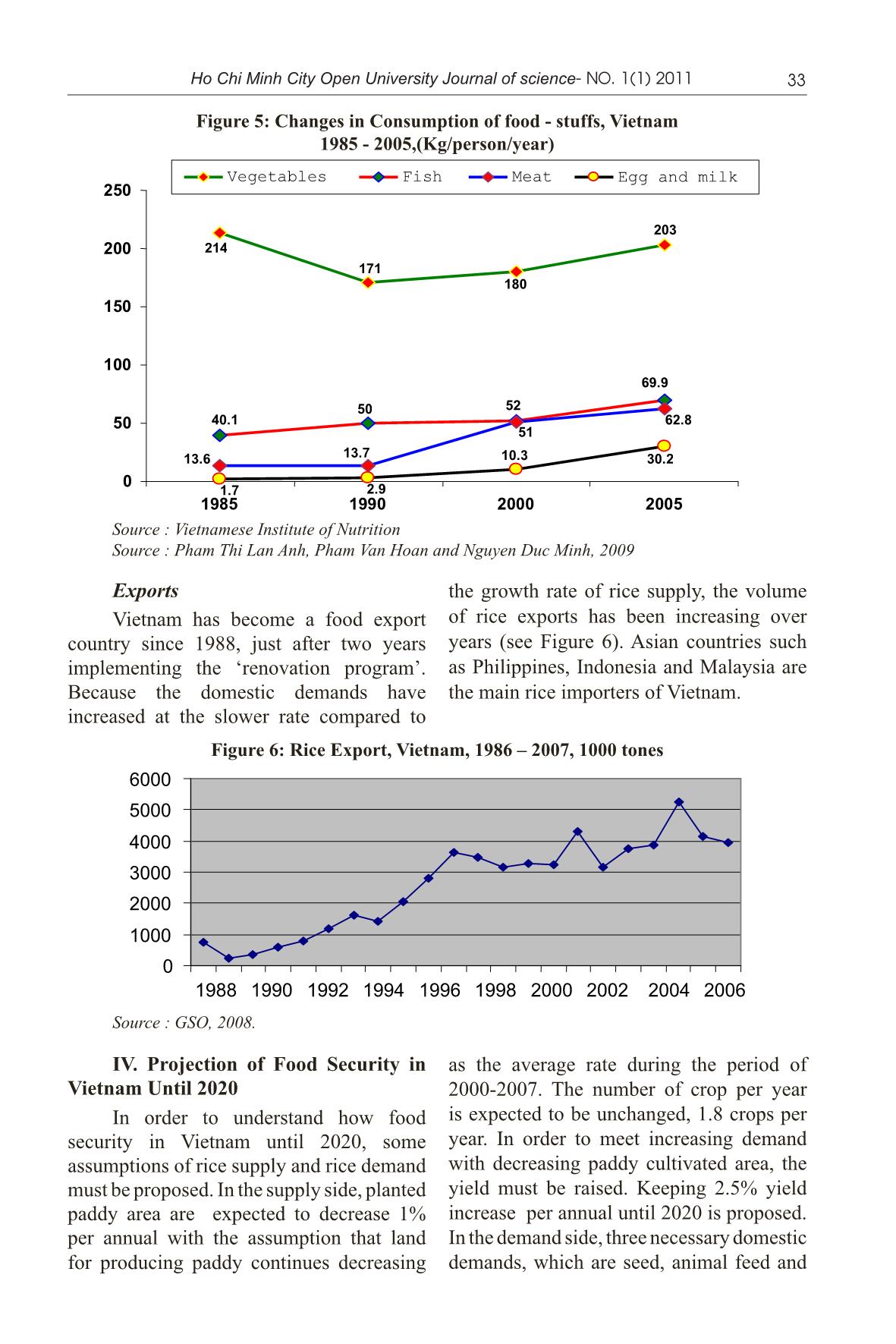
Trang 7
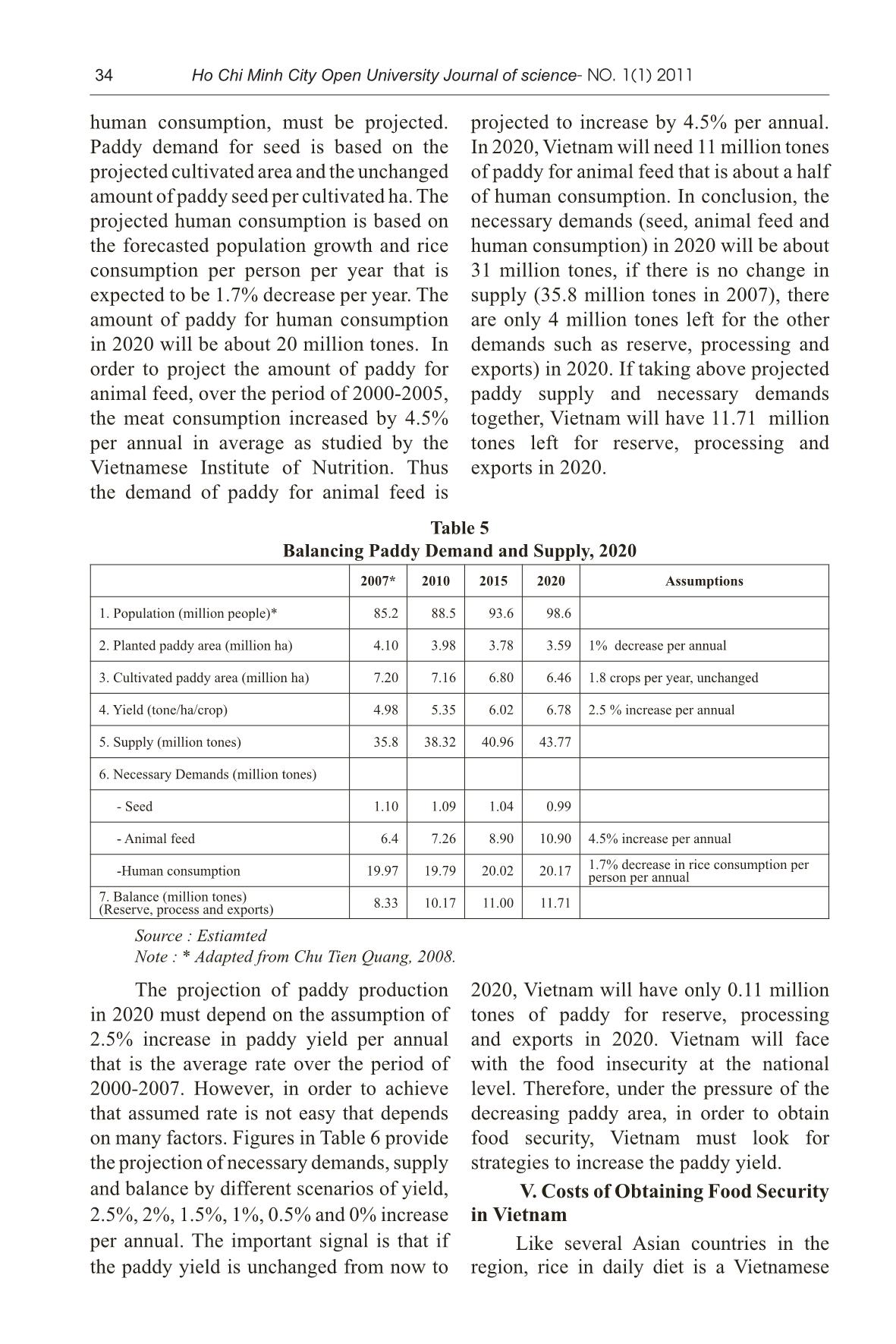
Trang 8
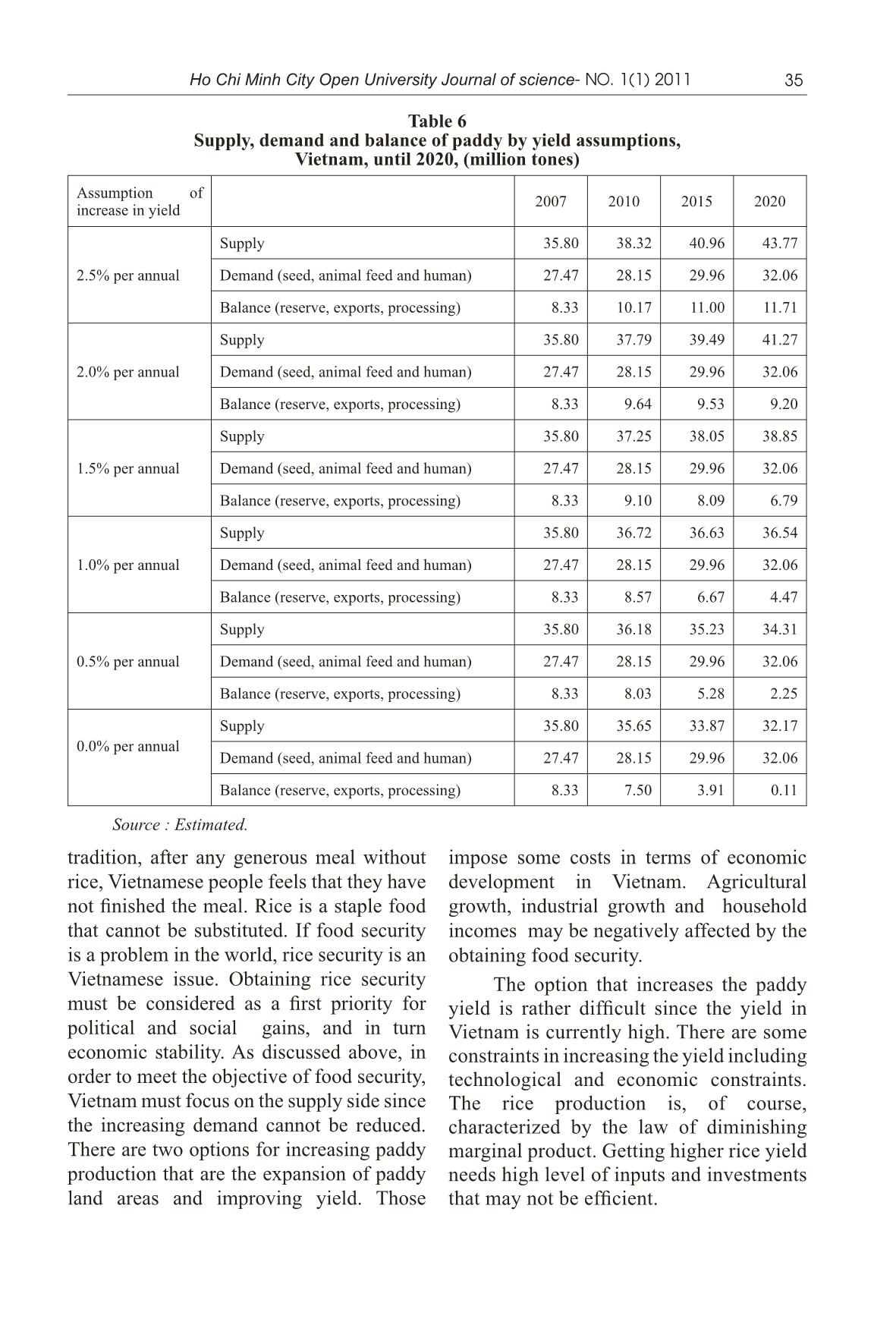
Trang 9
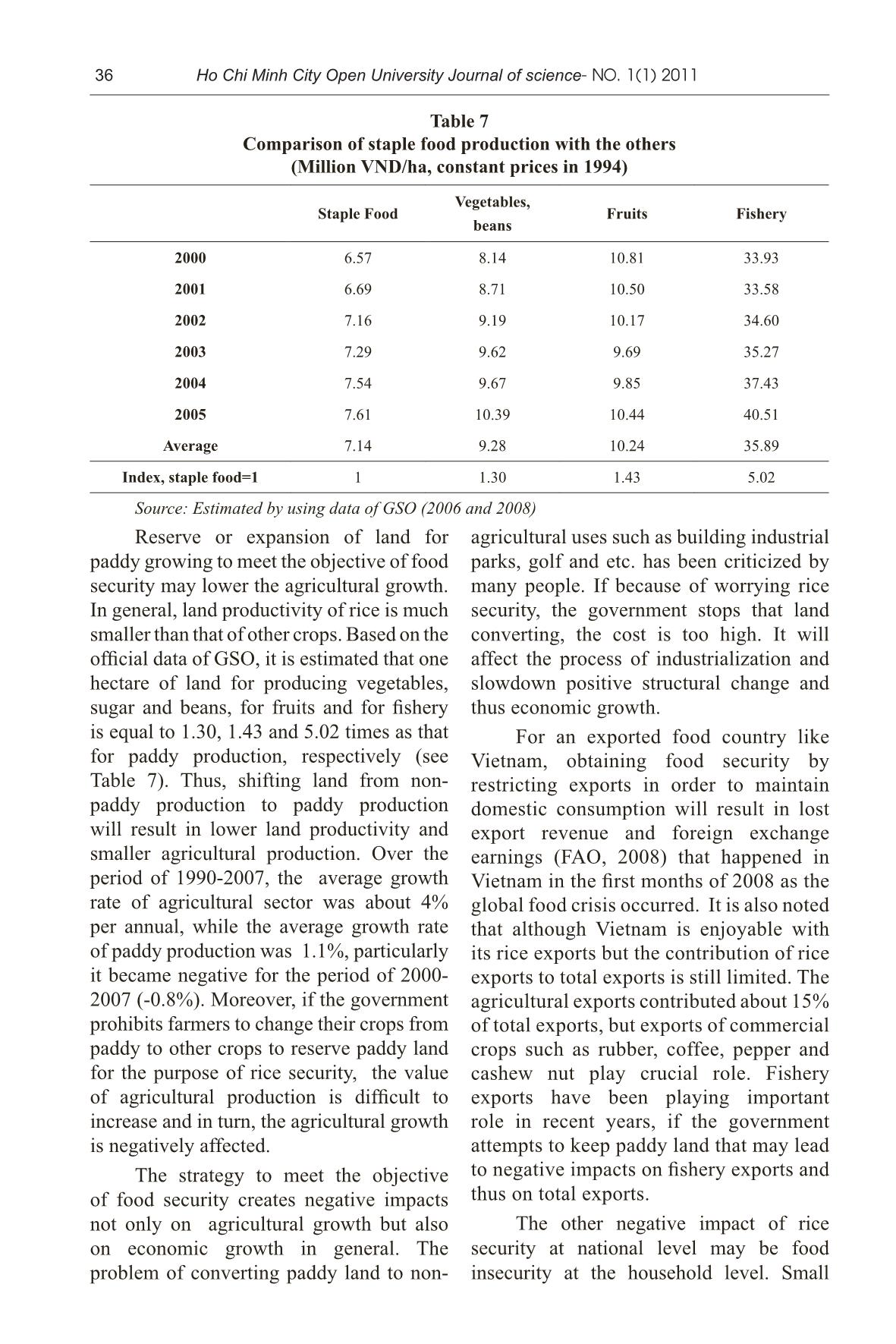
Trang 10
Tải về để xem bản đầy đủ
Bạn đang xem 10 trang mẫu của tài liệu "The costs of obtaining food security in Vietnam", để tải tài liệu gốc về máy hãy click vào nút Download ở trên
Tóm tắt nội dung tài liệu: The costs of obtaining food security in Vietnam
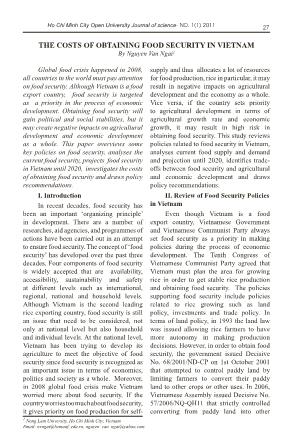
ssumption that land for producing paddy continues decreasing as the average rate during the period of 2000-2007. The number of crop per year is expected to be unchanged, 1.8 crops per year. In order to meet increasing demand with decreasing paddy cultivated area, the yield must be raised. Keeping 2.5% yield increase per annual until 2020 is proposed. In the demand side, three necessary domestic demands, which are seed, animal feed and 214 171 180 203 40.1 50 52 69.9 13.6 13.7 51 62.8 1.7 2.9 10.3 30.2 0 50 100 150 200 250 1985 1990 2000 2005 Vegetables Fish Meat Egg and milk 33Ho Chi Minh City Open University Journal of science- No. 1(1) 2011 2007* 2010 2015 2020 Assumptions 1. Population (million people)* 85.2 88.5 93.6 98.6 2. Planted paddy area (million ha) 4.10 3.98 3.78 3.59 1% decrease per annual 3. Cultivated paddy area (million ha) 7.20 7.16 6.80 6.46 1.8 crops per year, unchanged 4. Yield (tone/ha/crop) 4.98 5.35 6.02 6.78 2.5 % increase per annual 5. Supply (million tones) 35.8 38.32 40.96 43.77 6. Necessary Demands (million tones) - Seed 1.10 1.09 1.04 0.99 - Animal feed 6.4 7.26 8.90 10.90 4.5% increase per annual -Human consumption 19.97 19.79 20.02 20.17 1.7% decrease in rice consumption per person per annual 7. Balance (million tones) (Reserve, process and exports) 8.33 10.17 11.00 11.71 Table 5 Balancing paddy demand and Supply, 2020 Source : Estiamted Note : * Adapted from Chu Tien Quang, 2008. human consumption, must be projected. Paddy demand for seed is based on the projected cultivated area and the unchanged amount of paddy seed per cultivated ha. The projected human consumption is based on the forecasted population growth and rice consumption per person per year that is expected to be 1.7% decrease per year. The amount of paddy for human consumption in 2020 will be about 20 million tones. In order to project the amount of paddy for animal feed, over the period of 2000-2005, the meat consumption increased by 4.5% per annual in average as studied by the Vietnamese Institute of Nutrition. Thus the demand of paddy for animal feed is projected to increase by 4.5% per annual. In 2020, Vietnam will need 11 million tones of paddy for animal feed that is about a half of human consumption. In conclusion, the necessary demands (seed, animal feed and human consumption) in 2020 will be about 31 million tones, if there is no change in supply (35.8 million tones in 2007), there are only 4 million tones left for the other demands such as reserve, processing and exports) in 2020. If taking above projected paddy supply and necessary demands together, Vietnam will have 11.71 million tones left for reserve, processing and exports in 2020. The projection of paddy production in 2020 must depend on the assumption of 2.5% increase in paddy yield per annual that is the average rate over the period of 2000-2007. However, in order to achieve that assumed rate is not easy that depends on many factors. Figures in Table 6 provide the projection of necessary demands, supply and balance by different scenarios of yield, 2.5%, 2%, 1.5%, 1%, 0.5% and 0% increase per annual. The important signal is that if the paddy yield is unchanged from now to 2020, Vietnam will have only 0.11 million tones of paddy for reserve, processing and exports in 2020. Vietnam will face with the food insecurity at the national level. Therefore, under the pressure of the decreasing paddy area, in order to obtain food security, Vietnam must look for strategies to increase the paddy yield. v. Costs of Obtaining Food Security in vietnam Like several Asian countries in the region, rice in daily diet is a Vietnamese 34 Ho Chi Minh City Open University Journal of science- No. 1(1) 2011 tradition, after any generous meal without rice, Vietnamese people feels that they have not finished the meal. Rice is a staple food that cannot be substituted. If food security is a problem in the world, rice security is an Vietnamese issue. Obtaining rice security must be considered as a first priority for political and social gains, and in turn economic stability. As discussed above, in order to meet the objective of food security, Vietnam must focus on the supply side since the increasing demand cannot be reduced. There are two options for increasing paddy production that are the expansion of paddy land areas and improving yield. Those impose some costs in terms of economic development in Vietnam. Agricultural growth, industrial growth and household incomes may be negatively affected by the obtaining food security. The option that increases the paddy yield is rather difficult since the yield in Vietnam is currently high. There are some constraints in increasing the yield including technological and economic constraints. The rice production is, of course, characterized by the law of diminishing marginal product. Getting higher rice yield needs high level of inputs and investments that may not be efficient. Table 6 Supply, demand and balance of paddy by yield assumptions, vietnam, until 2020, (million tones) Source : Estimated. ofAssumption increase in yield 2007 2010 2015 2020 2.5% per annual Supply 35.80 38.32 40.96 43.77 Demand (seed, animal feed and human) 27.47 28.15 29.96 32.06 Balance (reserve, exports, processing) 8.33 10.17 11.00 11.71 2.0% per annual Supply 35.80 37.79 39.49 41.27 Demand (seed, animal feed and human) 27.47 28.15 29.96 32.06 Balance (reserve, exports, processing) 8.33 9.64 9.53 9.20 1.5% per annual Supply 35.80 37.25 38.05 38.85 Demand (seed, animal feed and human) 27.47 28.15 29.96 32.06 Balance (reserve, exports, processing) 8.33 9.10 8.09 6.79 1.0% per annual Supply 35.80 36.72 36.63 36.54 Demand (seed, animal feed and human) 27.47 28.15 29.96 32.06 Balance (reserve, exports, processing) 8.33 8.57 6.67 4.47 0.5% per annual Supply 35.80 36.18 35.23 34.31 Demand (seed, animal feed and human) 27.47 28.15 29.96 32.06 Balance (reserve, exports, processing) 8.33 8.03 5.28 2.25 0.0% per annual Supply 35.80 35.65 33.87 32.17 Demand (seed, animal feed and human) 27.47 28.15 29.96 32.06 Balance (reserve, exports, processing) 8.33 7.50 3.91 0.11 35Ho Chi Minh City Open University Journal of science- No. 1(1) 2011 Staple Food vegetables, beans Fruits Fishery 2000 6.57 8.14 10.81 33.93 2001 6.69 8.71 10.50 33.58 2002 7.16 9.19 10.17 34.60 2003 7.29 9.62 9.69 35.27 2004 7.54 9.67 9.85 37.43 2005 7.61 10.39 10.44 40.51 Average 7.14 9.28 10.24 35.89 Index, staple food=1 1 1.30 1.43 5.02 Table 7 Comparison of staple food production with the others (million vNd/ha, constant prices in 1994) Source: Estimated by using data of GSO (2006 and 2008) Reserve or expansion of land for paddy growing to meet the objective of food security may lower the agricultural growth. In general, land productivity of rice is much smaller than that of other crops. Based on the official data of GSO, it is estimated that one hectare of land for producing vegetables, sugar and beans, for fruits and for fishery is equal to 1.30, 1.43 and 5.02 times as that for paddy production, respectively (see Table 7). Thus, shifting land from non- paddy production to paddy production will result in lower land productivity and smaller agricultural production. Over the period of 1990-2007, the average growth rate of agricultural sector was about 4% per annual, while the average growth rate of paddy production was 1.1%, particularly it became negative for the period of 2000- 2007 (-0.8%). Moreover, if the government prohibits farmers to change their crops from paddy to other crops to reserve paddy land for the purpose of rice security, the value of agricultural production is difficult to increase and in turn, the agricultural growth is negatively affected. The strategy to meet the objective of food security creates negative impacts not only on agricultural growth but also on economic growth in general. The problem of converting paddy land to non- agricultural uses such as building industrial parks, golf and etc. has been criticized by many people. If because of worrying rice security, the government stops that land converting, the cost is too high. It will affect the process of industrialization and slowdown positive structural change and thus economic growth. For an exported food country like Vietnam, obtaining food security by restricting exports in order to maintain domestic consumption will result in lost export revenue and foreign exchange earnings (FAO, 2008) that happened in Vietnam in the first months of 2008 as the global food crisis occurred. It is also noted that although Vietnam is enjoyable with its rice exports but the contribution of rice exports to total exports is still limited. The agricultural exports contributed about 15% of total exports, but exports of commercial crops such as rubber, coffee, pepper and cashew nut play crucial role. Fishery exports have been playing important role in recent years, if the government attempts to keep paddy land that may lead to negative impacts on fishery exports and thus on total exports. The other negative impact of rice security at national level may be food insecurity at the household level. Small 36 Ho Chi Minh City Open University Journal of science- No. 1(1) 2011 farm households keeping their small rice farm may not lead them to a low income family who cannot access to food and thus the food insecurity at household level. vI. Conclusions and policy Recommendations There is a trade-off between obtaining food security and economic development in Vietnam. The increase in food demand as population pressure is unavoidable. In order to meet increasing demand, rice supply must be increasing. In order to increase rice supply to obtain food security, political and social stability can be achieved, but some negative impacts on economic development occur. Keeping or expansion of paddy land for food security will dampen agricultural growth and thus economic growth as a whole, because of forgone high land productivity of the other crops. Lower land productivity for paddy production cannot improve incomes of poor rice farmers that result in food insecurity at the household level. Because of food security, preventing from the using paddy land for the purpose of industrialization may harm the industrial development and thus economic development as a whole. Regarding to the issue of food security in Vietnam, this study recommends some policies as follows. The government should set a priority on increasing the paddy yield rather than regulating changes of land areas. If the paddy yield is not increased, the food security may achieve until 2020, however, the problem will become serious after 2020. Increasing paddy yield is not simple, it requires a lot of investments. Improving technology must be considered as a decisive strategy, biotechnology in particular. Since there are different types of demand for rice, the strategy of variety selection becomes important issue. In general, a high-yield variety usually results in low quality and vice versa. High-quality varieties must be applied for rice exports, while high-yield varieties are grown for animal feed and middle-quality varieties with middle-yield should be grown for human consumption. Global food crisis generates more benefits than harms for Vietnamese agricultural sector and economy. Because Vietnam has been a net food export country, it benefits from high international food price as a result of global food crisis. Food insecurity in the world is an opportunity for Vietnam obtaining food security at both national and household levels. Vietnamese rice farmers get benefits from higher price and thus they do more investments and get higher yield that results in more supply and positive impacts on food security at national level. Poor rice farmers now get more incomes from their small amount of rice selling. Higher international rice price will bring more foreign exchanges from the some volume of rice exports. However, high prices of food my lead to difficulties in macroeconomic management that affects economic growth in the short run and in the long run. Higher prices of food significantly influence consumer price index (CPI) because food expenditures share about 47% of Vietnamese consumers’ basket. High CPI leads to inflation that may be a problem for macroeconomics. vII. References Chu Tien Quang, 2008, San Xuat Lua Gao va Van De An Ninh Luong Thuc o Viet Nam [Rice Production and Problems of Food Security in Vietnam], Bao cao Hoi Nghi Khoa Hoc Kinh Te, 27- 28/11/2008, Hanoi. FAO, 2008. The state of food insecurity in the world, icatalog/ inter-e.htm General Statistical Office (GSO), 2007. Statistical Yearbook 2006, Statistical Publishing House, Hanoi. General Statistical Office (GSO), 2008. Statistical Yearbook 2007, Statistical Publishing House, Hanoi. 37Ho Chi Minh City Open University Journal of science- No. 1(1) 2011 GSO, 2009. ‘Consumption expenditure and consumption expenditure for living’, extracted from Vietnam Household Living Standard Survey, gso.org.vn Nguyen T. Song An and others, 2001. Household Food Security in the Tu Giac Long Xuyen. Research Project, Code: B99-22-50. Nguyen Van Sanh (2005) ‘Food Security, Livelihood and Rural Development’, A Report at a Workshop on Food Security in Vietnam in Nong Lam University, October 2005. Pham Thi Lan Anh, Pham Van Hoan and Nguyen Duc Minh, 2009. ‘Nguy Co Mat An Ninh Thuc Pham do Bien Dong ve Tu Nhien va Kinh Te Xa Hoi [Risk of losing foodstuff security due to Natural and Socio-economic changes]’, ( vn/Information%20Service/Report/ Plenary%20Meeting%20Report%20 17-11-2008/Group%203/Bao%20 cao%20tham%20luan%20Bo%20 Y%20te%20(Mr.Hoan).doc Trang Thu Huy Nhat and Tran Quang Van, 2008. ‘Food security and rural development’ in Bases for Territory- based Rural Development in the Southeast Region, Vietnam, Nguyen Van Ngai and Le Thanh Loan (eds.),VNU-HCM Publisher, Ho Chi Minh City. Trung Tam Tin va Tu lieu, CIEM, 2008. Dam Bao An Ninh Luong Thuc The Gioi va Viet Nam [Obtaining Food Secrity in the World and Vietnam]. ciem.org.vn/home/vn/home/InfoList. jsp?area=1&cat=124:bang Vietnam Media, 2008. ‘Vietnam co nguy co mat 5 trieu tan thoc do bien doi khi hau, [Vietnam can lose 5 million tomes of paddy per year due climate changes]’, 38 Ho Chi Minh City Open University Journal of science- No. 1(1) 2011
File đính kèm:
 the_costs_of_obtaining_food_security_in_vietnam.pdf
the_costs_of_obtaining_food_security_in_vietnam.pdf

